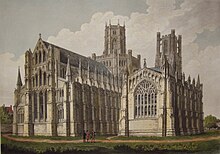John Buckler (artist)
John Buckler | |
|---|---|
| Born | John Buckler 30 November 1770 Calbourne, Isle of Wight, England |
| Died | 6 December 1851 (aged 81) Newington, London, England |
| Nationality | English |
| Children | John Chessell Buckler (son) |
| Relatives | Charles Alban Buckler (grandson) |

John Buckler, Snr
Biography
Buckler was born in
Buckler's interest in art developed over time, and his first published works were two
John Buckler died in Newington, London, in 1851, two years after his retirement. Forty-two volumes of his sketches[6] are now held by the British Library;[7] other places holding collections of his work include the Wiltshire Museum at Devizes, Taunton Museum, the William Salt Library in Stafford and the Bodleian Library in Oxford.[2][4]
Family
His eldest son, John Chessell Buckler (1793–1894), also an architect and artist, wrote several illustrated books on the history of British architecture, and his youngest son, George Buckler (1811–1886), and grandson Charles Alban Buckler (1825–1905) practised as architects as well. The Buckler family of architects and topographical artists has been the subject of a research project since 2013 hosted by the Institute for the History and Theory of Architecture at ETH Zurich.[8][9]
References
- ^ a b Colvin, 1997
- ^ a b c d e Tyack, 2004
- ^ "Summary Description of a Listed Buildings – St John the Baptist's Church". Cadw. Retrieved 23 June 2018.
- ^ a b "About the collection". Staffordshire Views Collection. Archived from the original on 5 July 2008. Retrieved 26 July 2008.
- ^ The Annual Register, Or, A View of the History and Politics of the Year 1851 (1852), London:George Woodfall & Son, p. 361.
- ^ Mixed with those of his son, J.C. Buckler, whose "pencil drawings of ancient buildings are almost indistinguishable in technique from those of his father" (Colvin).
- ^ Add. Mss. 36356-97
- ^ SAHGB (Society of Architectural Historians of Great Britain), Newsletter, No. 111 Winter/ Spring 2014, p. 81
- ^ "Thesis Project – The Buckler Dynasty 1792–1901". ETH Zurich. Retrieved 23 June 2018.
Sources
- ISBN 0-300-07207-4.
- Tyack, Geoffrey. "Buckler, John (1770–1851)". doi:10.1093/ref:odnb/3863. (Subscription or UK public library membershiprequired.)
